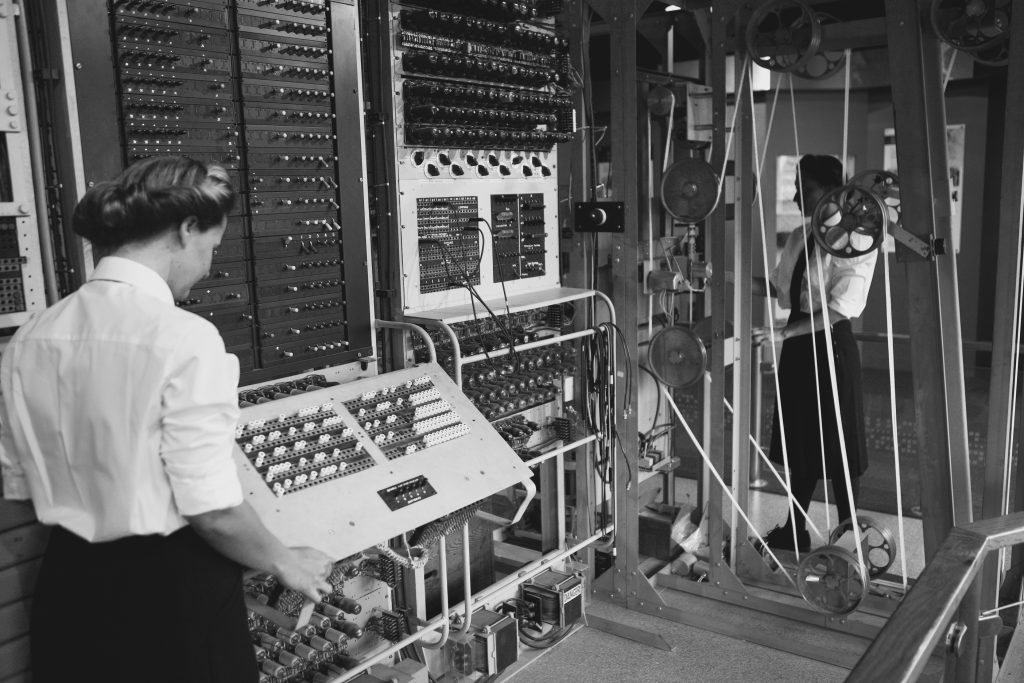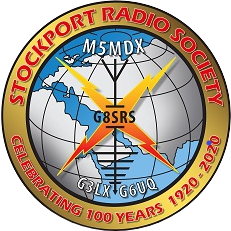
Photo courtesy of Bletchley Park Museum.
GB0COL is a special event station hosted by Stockport Radio Society (SRS) to commemorate the 80th anniversary of the beginning of operations of the second variant of the world’s first fully electronic computer, ‘Colossus’, on 1 June 1944 – just prior to ‘D-Day’, the Allied landings in France (on 6 June).
Colossus was developed as a quick and efficient method to decrypt the ‘unbreakable’ top secret radio teleprinter traffic, designated ‘Tunny’, sent by the High Command of the German armed forces and, so, played a critical role in bringing the Second World War in Europe to an end.
QRV times, and modes to be used.
GB0COL will be operational from SRS’s meeting place at Walthew House, Shaw Heath, Stockport, on various days during the month of June: specifically, on the evenings of the 4th and 25th (the month’s first and fourth Tuesdays) as well as during the day of Saturday the 8th and 22nd.
Bands and modes to be used include 2-metre FM, SSTV (around 144.500MHz), VHF digital voice, plus, on HF, SSB, CW and – perhaps most appropriately – radioteletype (RTTY). On the Saturday, weather permitting, we will also be operating through the QO-100 satellite.
Please keep a watch on DX Summit (www.dxsummit.fi) through which we will announce our specific operating frequencies and modes when we’re QRV.
If you wish to arrange a ‘sked’ with us, please email us in advance. Also, we will try to monitor our email as much as possible while QRV, for any real-time sked requests.
Station Information
Callsign: GB0COL
IARU Locator: IO83WJ
WAB Square: SJ88
IOTA: EU-005
Email: [email protected]
QRZ Page: https://www.qrz.com/db/GB0COL
Location @ Address for correspondence
Stockport Radio Society, Walthew House, 112 Shaw Heath, Stockport, England, SK2 6QS
QSLing, LOTW and Club Log
We intend to primarily acknowledge QSLs electronically through EQSL, Club Log and Logbook of the World (LotW).
However, we will produce physical QSL cards upon request to be sent directly to the operator in question. Folks (both in the UK and abroad) who would like paper cards should send us the equivalent of GBP2.00 (net of commission) to SRS’s PayPal account. Please follow the instructions for how to make payments to us via PayPal on the following webpage: http://www.g8srs.co.uk/paymentstosrs/. In the comments, please state ‘GB0COL QSL card for [your callsign]; [date, time, frequency and mode used of/for QSO]; [your postal address]’.
The ‘Lorenz code’
While many people are familiar with Bletchley Park’s breaking of Morse messages sent on the Enigma machine, relatively few know about the equally brilliant cracking of the ‘Lorenz code’ (really a ‘cipher’), used to encrypt teleprinter (or teletype) traffic.
Like the Enigma machine, the Lorenz SZ40 and SZ42 devices used a series of moving wheels (or rotors) to encipher plain text – 12(!) in the case of Lorenz. The operator sending the message would set up the wheels and, when done so, type out a message in plain text, which the machine would convert into ‘ciphertext’, ready to be sent ‘securely’ over landline or radio. For the encrypted message to be read at the receiving end (i.e. reconverted to plain text), the rotor settings at the sender’s end at the beginning of the message needed to be replicated on the receiver’s machine. The probability that a random guess of the initial wheel settings would be exactly the same as the sender’s was one in 16 billion billion!
Yet, a brilliant mathematician working on the Lorenz cipher at Bletchley Park, Bill Tutte, could detect repetitive patterns – ‘resonances’ – in the apparently random jumbles of teletype characters plucked out of the ether. From these, he could eventually calculate initial wheel settings. In fact, Tutte correctly deduced the number of rotors of the Lorenz machine, as well as their respective purposes – all without ever having laid eyes on the device!
Given enough time, Lorenz could, indeed, be broken. But time was a luxury the Allies did not have. So, primitive ‘thinking machines’ were developed that could make the process far more rapid. The culmination of these was the aptly codenamed ‘Colossus’, the development of which was overseen by Tommy Flowers, working at the Post Office Research Station at Dollis Hill, London. As brilliant an engineer as Tutte was a codebreaker, Flowers had the ‘Mark 1’ of his Colossus ready in good time, becoming operational at Bletchley in December 1943, months before the Allied invasion of Europe. The much improved ‘Mark 2’ went live on the eve of the D-Day landings.
Something ‘Fishy’ about German radio teletype
When reading histories of the Colossus machine and its wartime target, the Lorenz machine, you’ll come across references to ‘Fish’, ‘Tunny’ and ‘Sturgeon’.
Fish was the umbrella term given to German non-Morse (i.e. teleprinter) radio traffic and, in some circumstances, it refers to the encryption machines themselves. (For instance, in the days just after the end of the war in Europe, the Allies captured the gear – and the team that built it – which German crypto analysts constructed to replicate a high-level Soviet teletype device. This equipment soon became known as the ‘Russian Fish’. Given that Colossus machines were used until 1960, one suspects that much of the Colossi’s postwar employment was devoted to the USSR’s ‘Tunny’. The history of the final, fascinating decade and a half of Colossus’s operation has yet to be written.)
Why ‘Fish?’ British codebreakers established that the Germans referred to one of their teleprinter operations as ‘sawfish’ and, so, decided on using a similar reference for all of Germany’s encrypted teletype.
‘Tunny’ (tuna fish), on the other hand, related specifically to the signals encrypted by the Lorenz SZ40 and SZ42 devices. There was also ‘Sturgeon’, produced by the Siemens & Halske T43 and T52 machines. Sturgeon was never broken by the Allies, although it was rarely used, and cracking it was not considered critical.
The Colossus
To undertake the necessary calculations and counts for determining wheel settings, hundreds of valves were employed in each of the 12 Colossi built: 1600 in the Mark 1; 2400 (!) in Mark 2. Programmes were not stored in the machine as in modern-day computers. (The first of these being the ‘Manchester Baby’, which became operational in 1948.) Instead, the pattern of jumper leads in plugboards determined the tasks to be carried out.
Records of encrypted teletype detected by monitoring stations was ‘fed’ into Colossus by means of a large loop of perforated paper tape. With the Mark 2, the tape moved at up to 40 feet per second. Looking at that in terms of the reading of text, that was equivalent to 5000 characters!
The nature of ITA2 radio teletype (‘RTTY’), and how it aided Bletchley Park
Although encrypted with the Lorenz SZ40 and SZ42 machines, the underlying ‘code’ of the Tunny traffic was the standard International Telegraphy Alphabet No. 2, ‘ITA2’. (This is also the basis of amateur RTTY, still used today.)
Each digit and letter of the alphabet is conveyed by a specific string of five ‘bits’ of binary code (i.e. ‘1’s and ‘0’s). Slight differences in the frequency of the carrier wave will allow the receiver to distinguish between the 1s and the 0s, by using the technique of frequency shift keying (FSK). (Those who’ve heard RTTY on the amateur bands will be familiar with the jingling, caused by the rapid switching between the ‘mark’ (1) and ‘space’ (0) frequencies.)
You may have already realised that strings of five binary digits allow for only 32 possible combinations: 2x2x2x2x2 = 2 to the power of 5 = 32. Of course, all the letters of the Roman alphabet plus the complete set of Arabic numerals add up to more than that number, and certainly leaves no room for commas and full stops. Duplication of characters was essential. For instance, ‘00001’ could be either the letter ‘T’ or digit ‘5’. What to do?
A simple but ingenious workaround for this dilemma was the creation of two five-bit sequences which ‘told’ the receiving machine that the subsequent characters would be either letters or numbers/punctuation. Looking at the strings of bits for ‘figure shift’ (entered when the preceding text was letters and, subsequently, will be digits/punctuation) is ‘11011’; for ‘letter shift, it’s ‘11111’ – only a single bit differentiating the two. For traffic making its way smoothly through copper cabling, this is not a problem. However, the noise and signal fading commonly associated with HF radio mean that ITA2 teletype is far from robust when sent through the ether. Operators, therefore, would commonly attempt to ‘error proof’ their text by sending the shift characters twice, thereby making sure that the correct shift instruction would be received. Knowing that this repetition was occurring made BP’s task just that little bit easier. (Those with RTTY operating experience will no doubt have received ‘TOO’ instead of the expected ‘599’ signal report; this being due to the failure to detect the figure shift that comes immediately after a callsign – which will always end in a letter.)
‘Feeding’ Colossus: Receiving Tunny
Unlike the hand-sent Morse used with the Enigma machine, sent at about 20 words per minute, ITA2 teletype created characters at the rate equivalent to about 100 word per minute, which is far too rapid for humans to copy by ear. Instead, the ‘Y Service’ monitoring personnel (principally at the receiving station at Knockholt, Kent), used ‘undulators’ to record the text. Essentially, ink pens traced patterns over inch-wide moving paper tape; the pens would switch from side to side, in time the frequency shift, thereby showing the patters of 1s and 0s.
Encryption was not the only challenge faced by those trying to crack Lorenz: copying the signals accurately was essential for the decryption process and, in receiving them in Britain could be very difficult, given the distance from the German-operated stations and their use of directional antennas. Just getting the material to feed into Colossus was a great achievement in itself.
Sources: The Wikipedia articles titled: ‘Lorenz cipher’; ‘Fish (cryptography)’; ‘Colossus computer’; ‘Cryptoanalysis of the Lorenz cipher’.
Links
GCHQ celebrates 80 years of Colossus
Unseen images of code breaking computer that helped win WW2 (BBC News)
The National Museum of Computing – Colossus
